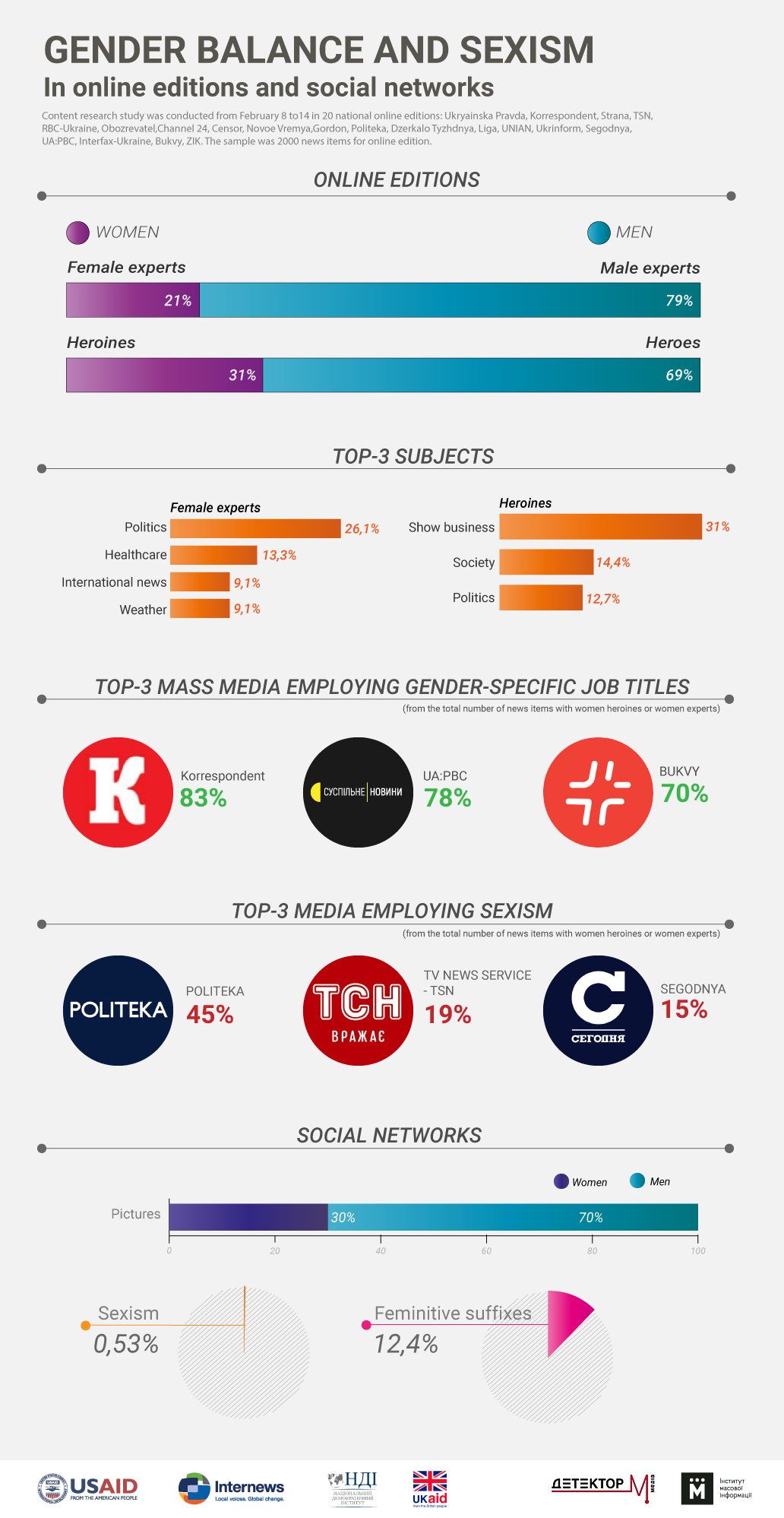IMI and “Detector Media” calculated the proportion of experts in the stories of national online editions and TV channels, investigated the most common manifestations of sexism and trends in the use of gender specific job-titles titles.
Ukrainian online editions and TV channels cited women as experts in an average of 28.2% of articles. Men were cited as experts almost three times more often : in 71.8%. Women-heroines are in 34% of the news items, men were in 66%. These are the results of the monitoring of Ukrainian online publications and TV channels conducted by the public organizations “Institute of Mass Information” and ” Detector Media ” in February 2021 *. Compared to the autumn of 2020, when the preliminary monitoring was conducted, the percentage of female experts and heroines increased by 1.2 and 3 percentage points, respectively.
Online edition
Comments female experts occurred only every fifth all news item in online publications: on average 21% female experts against 79% of male experts. Compared to the previous wave of monitoring (September-October 2021), the percentage of women experts increased by 2 percentage points.
Women as experts were most often involved in the materials of the Suspilne (or UA:PBC) website (48%), Obozrevatel (32%) and Politeka (30%), while the least comments of female experts were recorded in the “Dzerkalo Tyzhndya” (10%), in the online edition “Liga” (9%) and on the ZIK website (7%).
Ukrainian newsrooms most often cited women experts in the materials on political issues : 26.1% of the total number of mentions of women as experts . The MP Yevhenia Kravchuk became the leader in terms of the number of comments. Her colleague in the parliament, Marina Bardina, (Servant of the People), Yulia Tymoshenko (Batkivshchyna), Maria Ionova (European Solidarity) and Deputy Prime Minister Olga Stefanishyna gave also one’s comments.
The committee recommended that parliament punish MP Rudyk for sexism
Tymoshenko’s plan to reduce gas prices was supported by almost 500 local councils
In second place by number of comments were health women experts (13.3%) . In this topic, they commented on the coronavirus epidemic, nutrition and women’s health.
Wearing two masks at the same time better protects against COVID-19 – research
Pregnancy planning. How to prepare – advice from doctor Natalia Silina and parents’ stories
What to eat in winter time and what to eat to keep warm – tips from a nutritionist
In third place in terms of the number of expert comments from women in the online media were international topics and weather, which accounted for 9.1%. As for international issues, the leader in the number of expert comments was the Prime Minister of Lithuania Ingrida Šimonite. There were also isolated comments from Moldovan President Maia Sandu, Ms. German Ambassador to Ukraine Anka Feldguzen and Deputy Foreign Minister Emine Japarova .
Lithuania won’t buy Russian “Satellite V”, even if vaccine is approved in the EU – Prime Minister
The President of Moldova insists on the candidacy of the Prime Minister, rejected by the Parliament
The women experts also commented on social issues (8.5%), acted as departmental spokespersons (7.9%) and commented on business and economics (6.1%) and on technology and science (4.8%).

The percentage of women as heroines of online media news items (31%) still remains significantly lower than that of men as heroes (69%).
Most women as the heroines of the stories were recorded on the sites “Polyteka” (58%), “Obozrevatel” and TSN (46% each); the least were in the editions “Censor” (14%), “Interfax-Ukraine” (11%) and “Ukrainska Prvada” (9%). Therefore, in those online media that have a seemingly “balanced” percentage of heroes / heroines, women were in many cases the heroines of the tabloid-style news.
Every third news item that mentioned a female heroine was the show business news : 31%. The heroines of these news were foreign actresses, singers and Ukrainian celebrities. At the same time, these materials have a sufficiently high index of sexist tokens for women.
Half-naked Dasha Astafyeva was photographed in sauna
In 14.4% of the total number of news items, women figured as heroines of stories on social issues.
In 12.7% of the news items, women were the heroines of news on politics. The most mentioned were Yulia Tymoshenko (Motherland), Yevhenia Kravchuk (Servant of the People) and Marusya Zvirobiy, a servicewomen candidate from European Solidarity. Not so often they wrote about the women MPs Kira Rudyk (“Voice”), Elizaveta Bogutska (“Servant of the People”) and Anna Skorokhod (“For the Future”).
Virastyuk commented on Zviroboy’s popularity
Presidential rating: Zelensky’s rivals have closed the gap even more
In the crime news, the heroines appeared only in every tenth piece (11.9%) . Most often they were victims of road accidents, murders, relatives of the victims. There were also news about 6.7% female athletes. In another 6.5% of cases, women were the heroines of the news about the coronavirus epidemic. For example, as in this story about a 116-year-old woman:
I didn’t even know I had it: the oldest inhabitant of Europe recovered from COVID-19
There were significantly fewer heroines in the news about the culture : 6.7%, international topics 3.5%, life stories : 1.9%, science : 1.7% and human rights : 1.3%
Sexism in online media
Experts from the Institute of Mass Information noted that during the monitoring period, 5 out of 20 surveyed online media published sexist and discriminatory news targeting women.
The highest index of sexism was recorded in the following media: Politeka : 45% of the total number of news mentioning women. At the second place it was TSN (19% of all news about women had sexism elements), “RBC-Ukraine” with 15%, UNIAN with 14% and “Korrespondent” with 13% of the total number of news that mentioned women.
Famous women from show business or politicians are subjected to the most discriminatory texts. Most often, the media wrote about women’s faces, sexualized their bodies and focused on the breasts or buttocks.
Six stars who got old prematurely. Photo / “Obozrevatel”
56-year-old Taisiya Povaliy with a reshaped face showed how high she was under the snow / “Politeka”
The sexiest tennis woman player Angelina Shakhraichuk – photos of beauty / “Segodnya”
Breasts of size 15 helped an Ukrainian woman become famous – picture / “Segodnya”
Nadia Dorofeeva charmed with pictures in lingerie / “Korrespondent”
As for the women politicians, the Ukrainian media have been in detail looking up their clothes, accessories, hairstyles and manicures. However, these news did not mention a single word about activity of these women. At the same time, it should be noted that the experts did not find any story that would review the look of male politicians.
The IMI study showed that the key stereotype imposed in Ukrainian online media about women was increased attention to look. “Women’ appearance, this is her calling card,” “Every girl knows that her beauty is her appearance” (UNIAN), such imposed stereotypes of “femininity and beauty” became main trend in Ukrainian media.
The second most common stereotype was the sexualization of women. For example, in the material Women Lieutenant took a video for adults on a nuclear submarine (“Segodnya”), it was said that the couple had sex and filmed the process. But the news headline said that it was the woman who was taking the video. On the UNIAN website there were sex tips that concerned only women: “Confident girls who are not afraid of experiments should try this super pose.”
Also, the monitoring revealed the news with signs of order, promoting the brand of the “Eva” store chain, ” top 5 ideas that every woman would like . ” However, such tips arouse some questions: do women have the right to take a break from housework only “on their holiday”? It seems that on holidays, women are created to perform a certain set of stereotypical guidelines. The marketers with “Eva” need to research their audience more closely and not impose stereotypes in the 21st century.
“Always wished time off
Since March 8 is a holiday, it is supposed to relax this day and to forget about everything other. SO it would be a great idea to make a trip somewhere or to offer her a flight ticket. This present is to surprise your wife or girlfriend and will give some unforgettable moments.
You can make a little mountains ride week-end, at the shore or in some curious place to see.Also you could make a full-course holiday on the beach, but you should send a warning about in advance. And this is important, book your hotel one or two months in advance, while there are free rooms”.
In a recent IMI survey, 63% of media professionals said they always used femininitive suffixes. However, the results of online media monitoring evidences that, in fact, gender-specific job-titles are used in mass media very unsystematically. For example, the editors of “Interfax-Ukraine” news agency generally ignore the femininitive suffixes and mark the activity of women with the male designators of job. During the monitoring period, a meager index of femininitive suffixes was seen in the news of RBC-Ukraine : only 8% of the total number of mentions of women. In contrast to these examples, there are media that actively are using femininitive job suffixes: “Korrespondent” (83% of the total number of mentions of women), UA;PBC (78%) and “Bukvy” (70%).
Experts also monitored online media pages on social media for visual content, sexism and the use of femininitive suffixes. It turned out that in social networks, the media mostly illustrate posts with images of men (70% of posts), while pictures of women account for 30% . As for femininities, they are used in social networks in only 12.4% of the total number of posts. Interestingly, such a skew may not be in line with editorial practices. That is, online media can use femininities on its website, but not on social networks.
There were far fewer examples of sexism on social media than on the official pages of online media: less than 1% of posts contained sexism.
National TV channels
In the news of national TV channels from the sample **, which came out within the period from February 8 to 14, 2021 inclusive, there were 37.1% heroines and 62.9% heroes. Most often, women as the heroines of news stories appeared in the materials of the channels “Nash”, “Ukraina” STB, and “1 + 1”. Rarely it happened on Channel 5 and ICTV. But no TV channel had more female heroines than male heroes.
The largest number of female heroines was recorded in the news of the Nash TV channel (45%), while during the monitoring in September-October 2020, the most heroines were recorded on the STB TV channel (47.9% of women to 52.1% of men). In the news of the “Ukraina” TV channel, women accounted for 43% against 57% of men. On the air of the STB TV channel, the percentage of heroines was 42%, respectively, men was 58%. At “1 + 1”, the share of women was slightly lower : 41.5% of heroines and 58.5% of heroes. The worst percentage was recorded on ICTV (29.7% of women vs. 70.3% of men) and Channel 5 (28.8% of women vs. 71.2% of men). At the same time, the minimum representation of women increased by 8.5 percentage points : from 20.3% in October 2020 to 28.8% in February 2021.
Only 21.8% of speakers in TV talk shows were women, as opposed to 78.2% of male speakers. However, this figure increased by 4.4% compared to the ratio on the talk show in October 2020. The best ratio was on the talk show “Echo of Ukraine” on the Pryamyy Channel : 37.5% of women to 62.5% of men, as well as on the show “Countdown” on the UA:PBC : 36.3% of women to 63.7% of men. The worst was seen on “Freedom of speech with Savik Shuster” of the TV channel “Ukraina”: 11,1% of women and 88,9% of men.

Most often, female heroines were represented in stories on social issues. These are mothers of schoolchildren and kindergarteners, shop women, neighbors, volunteers, professionals of the cultural and service sectors. Curiously enough, due to the emergency caused by snowfall, many stories were devoted to this topic, including the situation on the roads. The vast majority of drivers who appeared in the stories were men, as well as representatives of rescue, fire and other services. But among the representatives of public utilities, the share of women was virtually equal. The share of women politicians who became the heroines of TV channels was very small.
Women’s Day in Science became an occasion for some separate stories only for ICTV, “Inter” and “1 + 1” TV channels. The latter also made a post about it on its Facebook page. Other TV channels did not pay attention to this day.
For three days in a row, the STB TV channel published posts on its Facebook page against gender stereotypes, stereotypes in society about real men and women. In particular, they announced a series of interviews with famous men about upbringing, stereotypes, “non-masculine” patterns of behavior and more. They raised the issue of perception of homework and childcare as a “women’s” business, the division of professions into men’s and women’s. However, these posts on the channel’s Facebook did not have much resonance and response from users.
And on February 10, the STB channel aired a story about bills against sexism, and about another row which occurred on this ground in parliament. The MP from the “For the Future” faction Serhiy Rudyk allowed himself to call his colleague a ” 32-year-old girl ” and expressed doubts about her competence. The story had several comments of women PMs, in particular of Inna Sovsun (“Voice”) who told that ” one should recognize it, sexism does exist and it is true. It does exist in the Verkhovna Rada, it does exist in the professional sphere, in work, it does exist in a real life “. Sovsun further gives an example: “She assures that this is very frequent that Ukrainian women face prejudice either at work or at home.” And I am told: oh, we used to have only smart ones, and now we have even beautiful ones”. The issues of sexism in advertising and legislative initiatives to solve this problem was raised. There are also comments of male MPs in the report, in particular of Oleksandr Kornienko, who was used to voice sexist attitude about women. ” As you can see, I am one of those who, unfortunately, who sometimes say it, I am agree that it will not be easy to relearn, but I have to do it sooner or later , ” the politician admitted.
Instead, many TV channels broadcast gender stereotypes in the stories. Thus, STB in the article about cleaners emphasizes that ” women cleaners can maintain the prestige of their profession: they are polite to people, they are dolled every day up. Although the hairstyles under the hats are not visible .” It is difficult to imagine such a passage about men of the same profession. Then the main character broadcasts stereotypical ideas about a woman with hair, makeup, even at a young age, but journalists don’t make effort to present it as not an axiom:
Heroine: We get dressed up and have hairstyles. And the lipstick (is put –n/tr).
Korrespondent: Hairstyles, makeup.
Heroine: Makeup, lips all painted. And the eyes are eye lined, so as they don’t think that we are here, working in the street, and with garbage, yes.
Reporter: You are all beautiful.
Heroine : I think everyone is young too.
There are many cases when beauty and appearance are presented as a prior value any woman had. An example is the STB story from February 12 about a girl whose hair was damaged in a barbershop (“The next story is like a terrible dream for any woman. Ruslana got her hair damaged in the salon shortly before the wedding “); the report aired by “Ukraina” from February 13 (” And while Ukrainians postpone travel, the gifts the women desire are still jewelry and cosmetics “). Certain stereotypes were voiced in the stories and live stands-up dedicated to Valentine’s Day. For example, that it is more difficult to please to women (“Espresso” TV, February 14) or that Valentine’s Day is inextricably linked to flowers. It is a tradition that men give flowers to their girls, because all girls love flowers“(“Nash”, February 14).
In the “1 + 1” story from February 14 about how women and men prepare for the holiday, there is a significant shift as they said that a woman had to make more efforts. ” Ukrainian women inscribe themselves to geisha school, to the lessons of intimate gymnastics, to get love coaches and love of astrologers and everything to find her other half ” – Alla Mazur said announcing the report. Instead, men, according to her, also do not sit idle: they go to seducers courses. In the story one could hear from various trainers and instructors such messages: ” One should labour at. To labour at oneself. At one’s inner condition, one’s sexuality. To spread one’s pheromones, hormones. Then you have a chance to find the right man “; “Various tricks that help a girl to find good man, to seduce him“;” The first and most important mistake the women make are: when a woman dashes away any initiative in a man, in the bud. She believes that no one will do better than her. The second mistake is also very serious, when women compete with men, “etc. The correspondents say that trying to find a right man,” a woman is willing to pay almost the entire monthly salary.” And a single man in the story say that his knowledge help to seduce women, and the latter are perceived as objects: ” Ex-seducer now teaches his clients not only to masterfully meet for sex, but also to make a dream girl to fall in love with you and form a couple .”
There are also examples of objectification in social networks, in particular, on the page of the TV channel “Ukraina” they told how one of the presenters, Maria Melnyk, was preparing for the birthday celebration of the program “Morning with Ukraine”. The presenter ” wore a clinging silver dress with an low neckline and complemented the look with beautiful earrings and a delicate hairstyle. She is terrific” The authors of the report invite readers to rate the image of Mary from 1 to 10.
There were 35.4% women experts in the news of TV channels against 64.6% of men. The highest percentage was recorded on “Espresso” and “Ukraina”. The fewest women experts were found in ICTV news.
In the news of the Espresso TV channel, the number of female experts was the same as the number of male experts : 50% to 50%. This is the best indicator of the channels from the sample during the monitoring period. Quite a high level of experts was recorded on “Ukraina” (47.5% of women experts and 52.5% of men experts), Pryamyy (42.9% of women experts and 57.1% of men experts) and 1 + 1 (41.4% of women experts and 58, 6% of men experts). The monitoring revealed three times fewer women experts (25%) in the news on STB and Nash TV channels compared to men (75%). The lowest percentage of women experts is recorded in ICTV news: 16.7% of women as opposed to 83.3% of men.
Women experts most often appeared in stories on social issues: comments were given by government women officials, women officials, women press officers, women law enforcement officials, women NGO representatives, women psychologists, women astrologers, women researchers, and so on. In the news related to jurisprudence, economics and politics, there were no comments from women experts.
“Detector Media” women experts also analyzed the Facebook pages of the sampled TV channels for the use of femininitive suffixes. There were no pages that did not use femininitive suffixes at all, as a principle: the analyzed pages were divided into those that use femininitive suffixes regularly and consistently (“1 + 1”, “Ukraina”, STB, Channel 5 and UA:PBC), and those that do so occasionally or irregularly. (ICTV, “Inter”, “NAsh”, 112, “Espresso” and Pryamyy). In particular, this category includes TV channels that have their Facebook pages in Russian. Manifestations of sexism in the posts of Facebook pages of TV channels were isolated and mentioned above.
* The study of online media content was conducted from 8 to 14 February 2021 inclusive in 20 national online media: “Ukrainska Pravda”, “Korrespondent”, “Strana.ua”, TSN.ua, “RBC-Ukraine”, “Obozrevatel” , 24tv.ua, “Censor.net”, nv.ua, “Gordon”, “Politeka”, “Dzerkalo tyzhdnya”, “Liga”, UNIAN, “Ukrinform”, “Segodnya”, “Suspilne. News”, “Interfax -Ukraine “,”Bukvy” and ZIK. The sample was 2,000 news items.
** The study of the content of TV channels covered news, summarizing weekly magazines and some socio-political talk shows that were broadcast in the period from 8 to 14 February 2021 inclusive on TV channels “Inter”, “1 + 1”, “Ukraina”, STB, ICTV, Channel 5, “Pryamyy”, “Nash”, 112 / NewsOne / ZIK (during the monitoring period, these threeTV channels broadcast the same thing), “Espresso” and “UA: Pershyy”. The sample covered 665 reports.
This study was created with the generous support of the British people through the UK Department for International Development through the Foundation for Good Governance and with the support of the American people through the USAID’s Media Program in Ukraine project implemented by an international organization. Internews. The contents are the sole responsibility of “Detector Media” and the “Institute of Mass Information”. The views expressed herein are those of the authors and do not necessarily reflect the views of the Department of International Development or Her Majesty’s Government, USAID, the United States Government or the Internews Network.



